Dynamic range in audio is a critical element, forming the heartbeat of every piece of music you create or listen to.
It can help you sculpt soundscapes, control the mood, and elevate your tracks to professional standards.
However, if you don’t know how to harness its power, you might find yourself lacking.
That’s why we’re breaking down everything you’ll need to know in order to master the art and science of dynamic range in music production.
In today’s article, we’ll be covering:
- What dynamic range is ✓
- Theoretical dynamic range vs actual dynamic range ✓
- Different dynamic range sizes (benefits & downfalls) ✓
- Importance of dynamic range audio ✓
- Measuring and shaping the dynamic range ✓
- Dynamic range compression ✓
- Signal-to-noise ratio and the noise floor ✓
- Advanced dynamic range tips & tricks ✓
- Streaming services & loudness normalization ✓
After diving into this comprehensive guide, you’ll not only gain a thorough understanding of dynamic range, but be equipped with advanced techniques to enhance your tracks.
You’ll be able to manipulate sound with finesse and meet the demands of various digital platforms and streaming services.
Therefore, you’ll bring your beats to life with greater clarity and impact.
So, let’s dive in…
Table of Contents
- What Exactly is Dynamic Range?
- Striking the Perfect Balance Between The Quietest Parts and Loudest Parts of Your Tracks
- Theoretical Dynamic Range vs Actual Dynamic Range
- The Different Dynamic Ranges: Breaking it Down
- Importance of Dynamic Range in Digital Audio Music Production
- Measuring and Shaping Dynamic Range
- Dynamic Range Compression
- Understanding Signal-to-Noise Ratio
- Managing The Noise Floor in Your Mix
- Bonus: Streaming Services & Loudness Normalization
- Dynamic Range Audio: Final Thoughts
What Exactly is Dynamic Range?
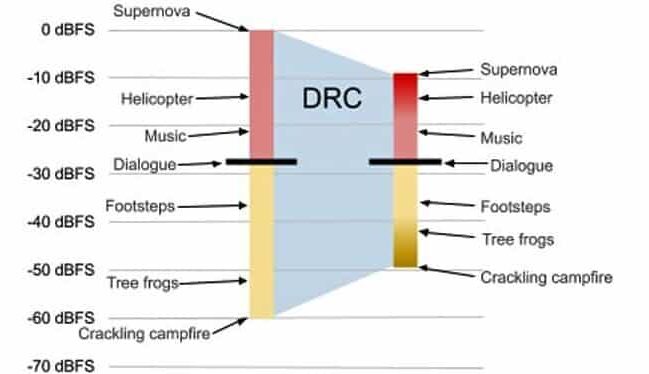
Dynamic range audio refers to the difference between the softest sound and the loudest sound in a track, measured in decibels (dB).
Picture a whisper followed by a thunderous drumbeat; that difference in loudness is essentially your dynamic range.
It brings life to music, creating emotional depth and texture.
Without dynamic range, music would be flat, uninteresting, and lack the peaks and valleys that give it character.
Understanding dynamic range is crucial for music producers, as it allows us to create a balanced mix, where each instrument and vocal has its place.
This ensures that no one element overshadows or overpowers another, which is super important.
In digital audio, dynamic range is also influenced by bit depth.
The higher the bit depth, the greater the potential dynamic range 一 offering more room for nuances and subtleties in the music.
NOTE: This is why high-resolution audio formats (with greater bit depths) are sought after for their ability to reproduce a more detailed and dynamic sound.
Dynamic range also plays a pivotal role in the listener’s overall auditory experience.
It can:
- Build tension
- Evoke emotions
- Keep the audience engaged
Mastering the use of dynamic range is an art form, essential for creating impactful and memorable music.
So, if you’re making music that you’d like to not only be unforgettable, but professional and chart-topping, understanding dynamic range is paramount.
Striking the Perfect Balance Between The Quietest Parts and Loudest Parts of Your Tracks
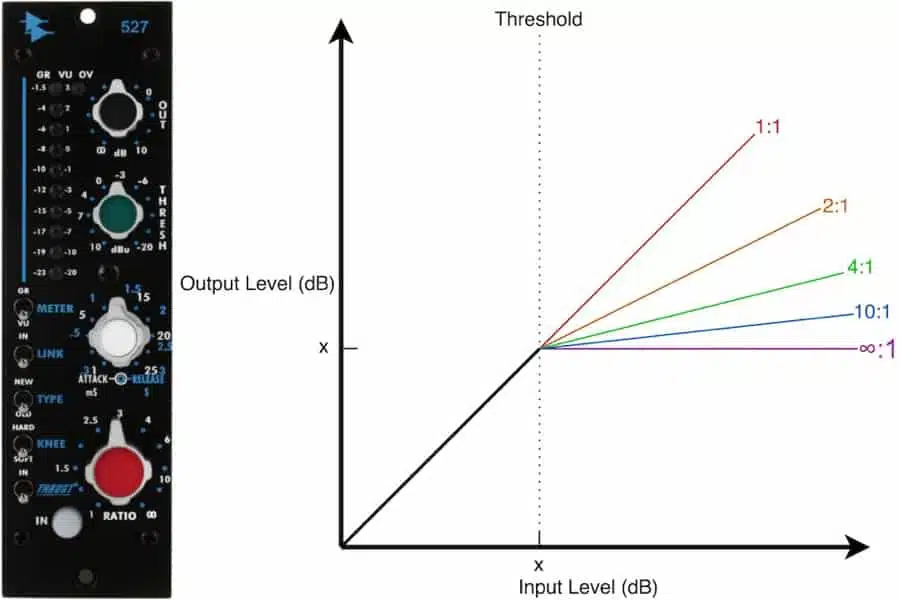
Striking the balance between the quietest sound and loudest sound of your tracks is like walking a sonic tightrope.
It’s about ensuring that the soft sounds are audible.
At the same time, it prevents the loud sounds from becoming overpowering or distorted.
This balance between the softest and loudest sounds is essential for maintaining clarity and depth in the music.
Different genres require different approaches to balancing dynamic range, for example:
- A symphonic piece 一 May have wide dynamic variations, with soft, delicate sections building up to powerful crescendos.
- A pop track 一 Might have a more compressed dynamic range, maintaining a consistent energy level throughout.
Achieving this balance involves careful, meticulous mixing and mastering.
Equalization, compression, and limiting are tools at the producer’s disposal to manipulate dynamic range.
They help to ensure each element of the track sits well in the mix.
By subtly adjusting these parameters, you can enhance the musicality and emotion of the track, drawing the listener into the sonic landscape you create.
Understanding how to strike this balance is crucial.
It involves a deep knowledge of the music, the intended emotional impact, and the technical tools available.
By mastering this balance, you can bring out the best in your music and craft memorable tracks that really resonate.
Theoretical Dynamic Range vs Actual Dynamic Range
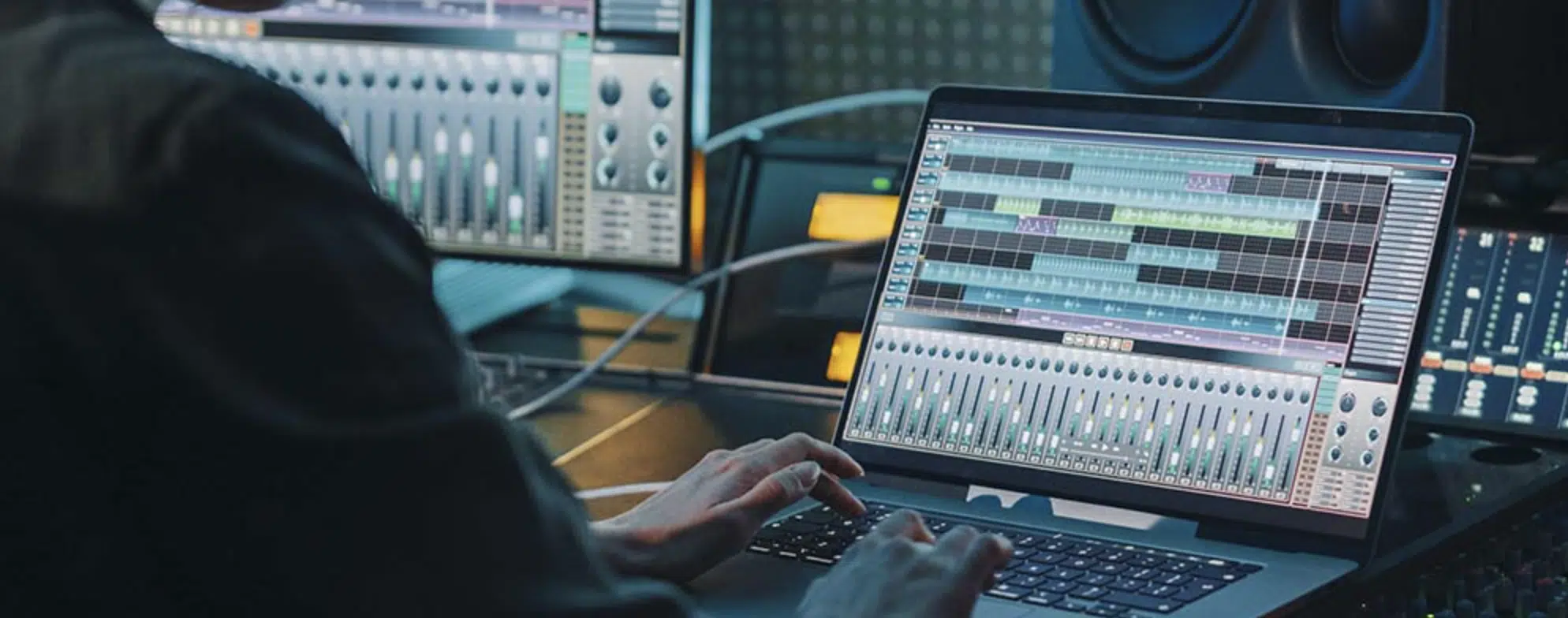
Before we dive deeper, let’s discuss the theoretical aspects of dynamic range and how they intertwine with practical applications.
It’s like decoding the DNA of sound, exploring how to shape and manipulate it to achieve the desired auditory experience.
In theory, dynamic range is a straightforward concept.
It’s the difference in volume between the loudest and softest parts of a sound.
However, in practice, achieving the ideal dynamic range can be a complex task, influenced by various factors such as:
- Audio recording equipment/audio gear
- The acoustic environment
- The source material
Understanding these factors and how they interact is essential for shaping the dynamic range effectively.
The theoretical dynamic range is often determined by the bit depth of the digital audio.
A higher bit depth allows for a wider dynamic range 一 providing more room for nuances and subtleties in the sound.
The actual dynamic range that is perceived by the listener can be influenced by other factors (such as the playback system and the listening environment).
Deciphering these theoretical aspects provides a foundation for practical application.
It allows you to anticipate challenges and make informed decisions when recording, mixing, and mastering.
By understanding the theory behind dynamic range, you can better navigate the complexities of the auditory world and create captivating soundscapes.
The Different Dynamic Ranges: Breaking it Down
When dealing with dynamic range, there are varying dynamic ranges (sizes) that each hold its own unique charm and challenges.
Let’s break this down so you know just how much dynamic range to incorporate 一 from a relatively modest dynamic range to over the top.
-
High Dynamic Range: Bigger, Bolder Sounds
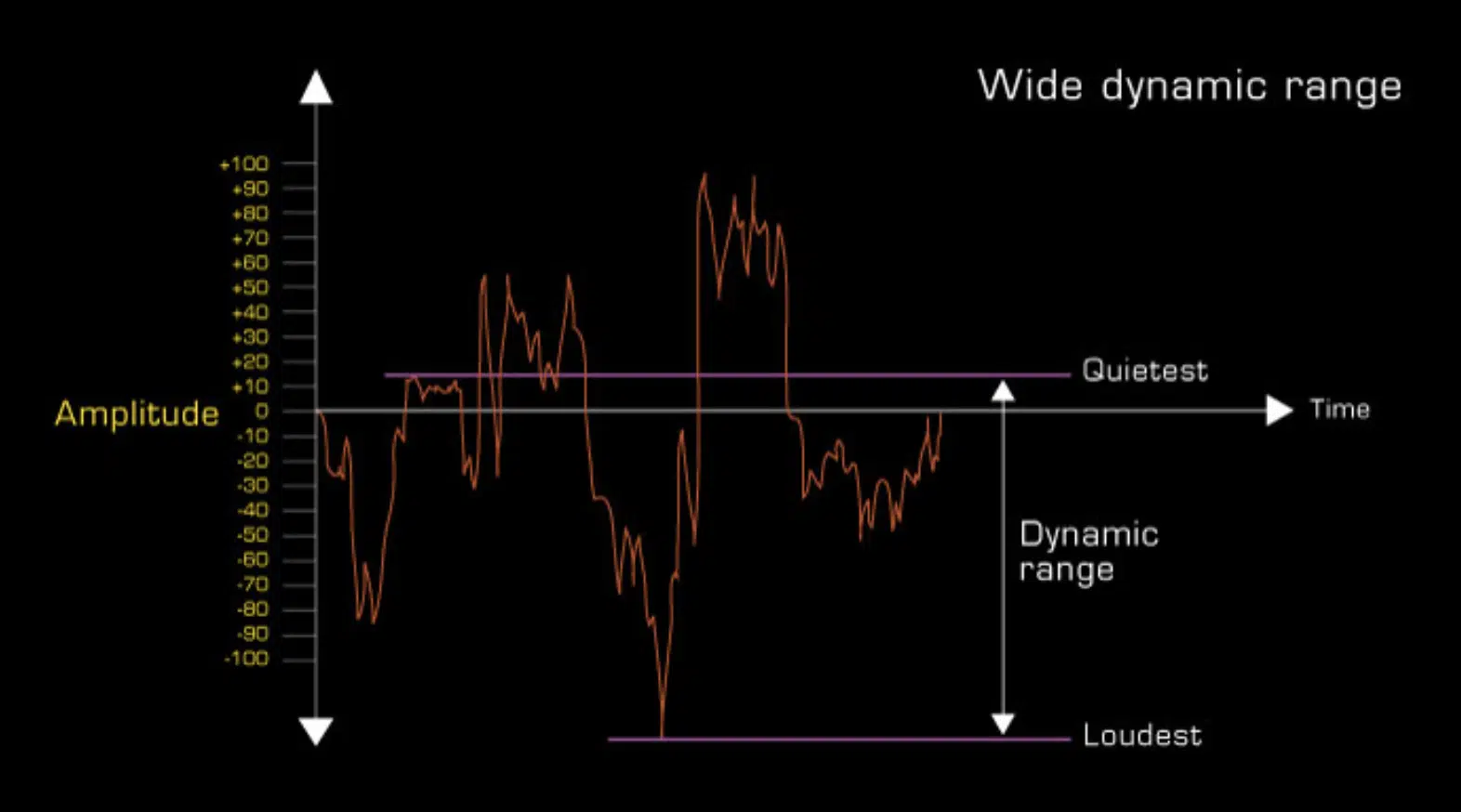
Diving into the realm of high dynamic range audio (also known as wide dynamic range) you’ll encounter bigger, bolder sounds that encompass a vast sonic spectrum.
HDR audio offers a rich tapestry of textures, from the subtlest whispers to the most powerful crescendos.
It helps to create a lifelike and immersive listening experience.
In HDR, the contrast between the quietest and loudest parts of a track is pronounced 一 allowing for greater emotional expression and musical storytelling.
This expansive dynamic range is essential in music genres like classical music and jazz, where nuanced performances and intricate compositions benefit from the added depth and clarity.
However, achieving a balanced and effective HDR sound is no small feat.
It requires meticulous recording, mixing, and mastering (mastering process) to ensure that the nuances are preserved without compromising the overall balance of the track.
To really harness the power of a higher dynamic range, you’ll need:
- Attention to detail
- Technical proficiency
- A deep understanding of music in general
HDR also poses challenges in playback, as not all listening environments and equipment can accurately reproduce the wide dynamic range.
Therefore, considering the end-listener’s experience and optimizing the audio for various playback scenarios are crucial steps in delivering impactful HDR music.
One striking example of embracing a wide dynamic range can be seen in Kendrick Lamar’s “m.A.A.d City.”
It intricately combines whispering vocals with intense, booming beats 一 allowing the subtleties of the background to be just as significant as the foreground.
This technique adds depth and dimension and draws listeners into the story unfolding.
NOTE: Striving for maximum dynamic range allows you to create compositions that fully utilize the spectrum between the quietest and loudest sounds.
This creates a rich and immersive auditory experience that you’ll need to stand out.
-
Low Dynamic Range: Subtlety in Sound
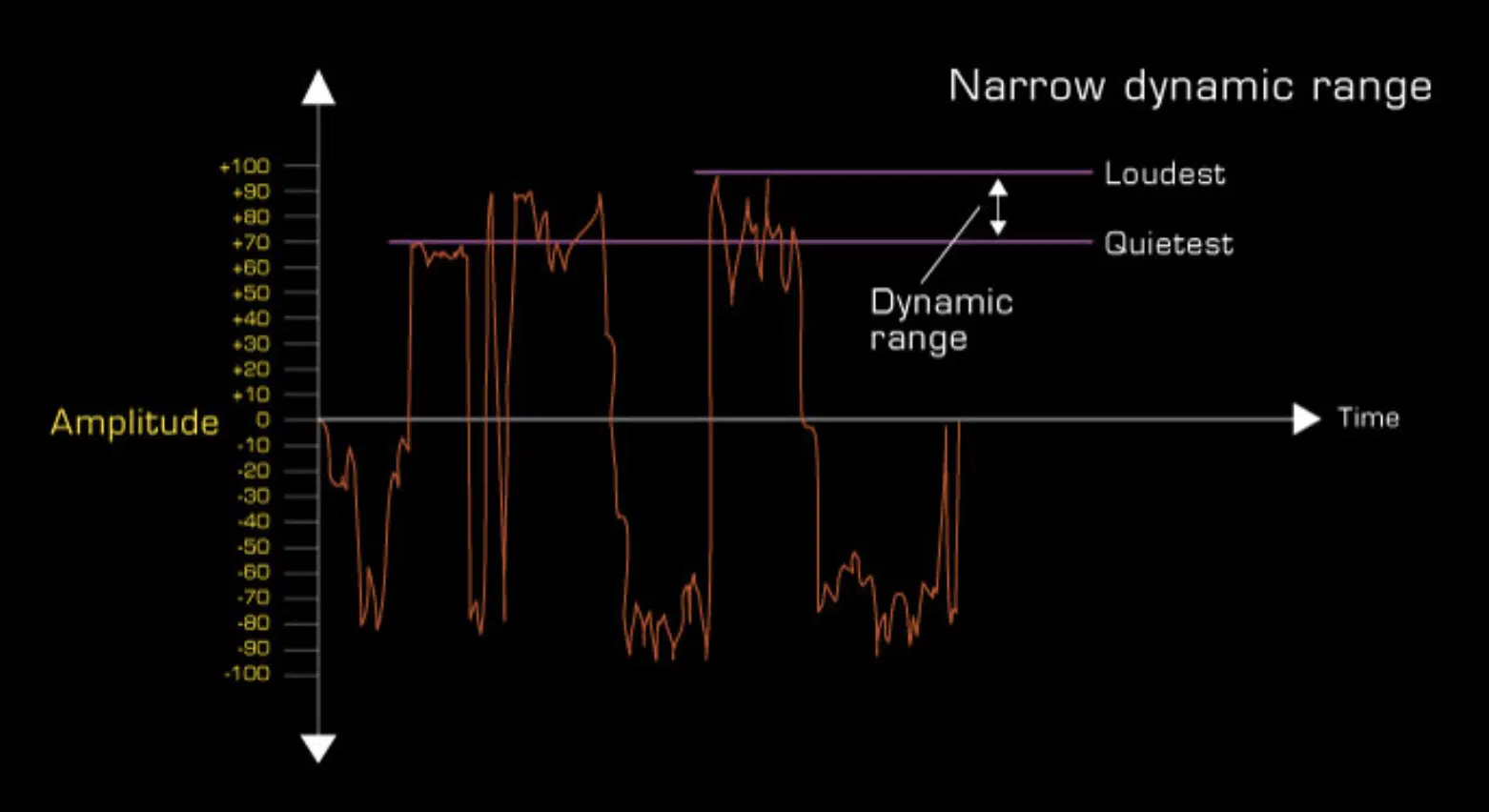
On the opposite end of the spectrum, low dynamic range audio (also known as narrow dynamic range) specializes in subtlety and consistency.
Low dynamic range is characterized by smaller differences between the quietest and loudest parts of a track 一 resulting in a more uniform and controlled sound.
LDR is commonly employed in genres such as:
- Pop
- Rock
- Electronic dance music (EDM)
This is because it requires a consistent energy level and a clear, upfront sound.
The reduced dynamic range ensures that every element of the track is audible and impactful, making LDR suitable for environments with ambient noise (such as cars and clubs).
While LDR offers clarity and consistency, it also requires careful consideration to avoid overcompression and loss of dynamics.
Striking the right balance between control and musicality is key to achieving a captivating LDR sound.
Understanding the genre, the intended audience, and the distribution platform is essential in tailoring the dynamic range to suit the music’s character and purpose.
Importance of Dynamic Range in Digital Audio Music Production
In the digital audio domain, dynamic range is the equilibrium that holds the digital soundscape together.
It’s a balancing act that plays a pivotal role in defining genres and shaping the listener’s experience.
So, let’s get into it so you can understand how to figure out your track’s ideal dynamic range.
-
The Balancing Act: Why it Matters
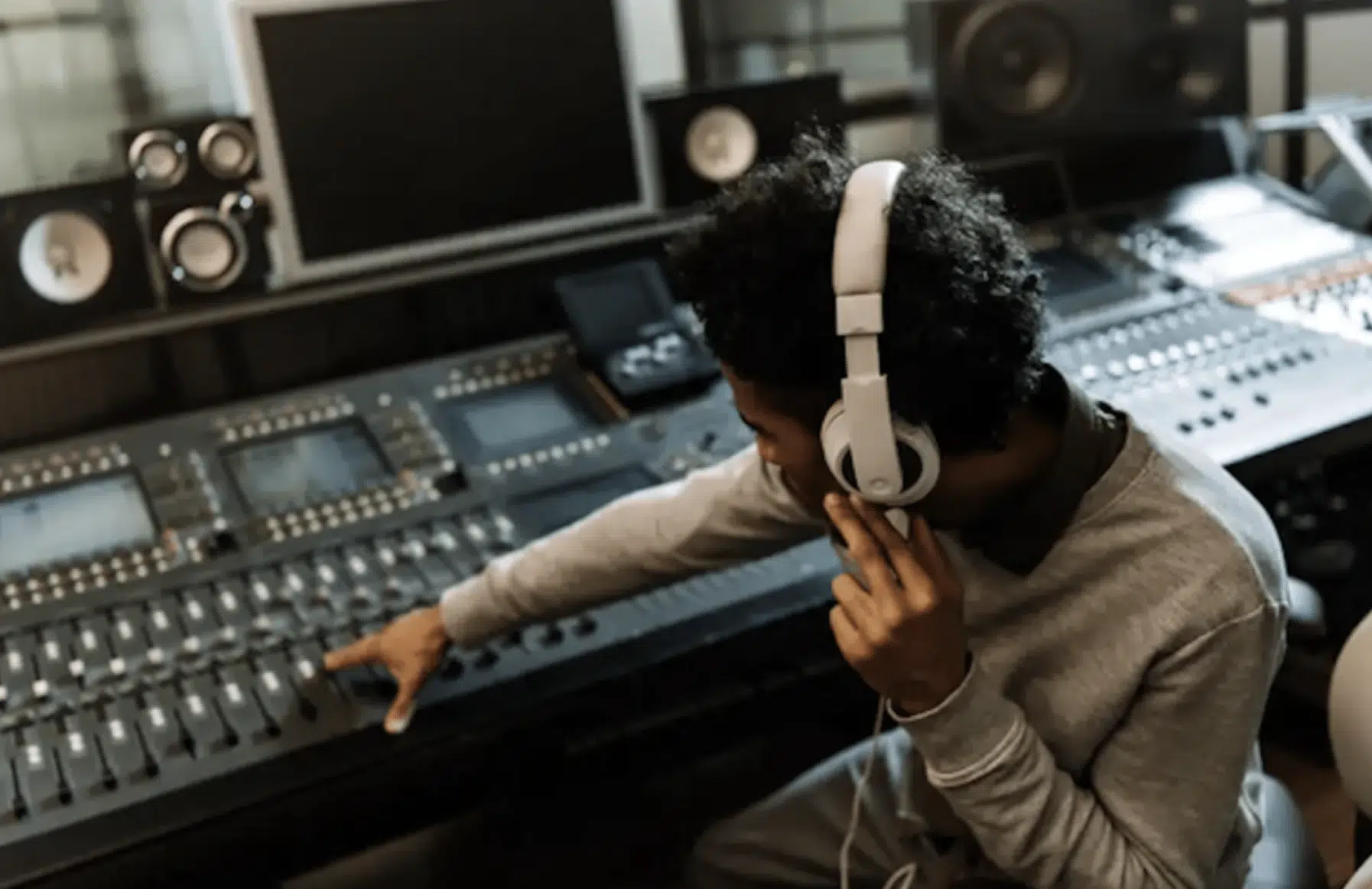
Dynamic range in audio serves as the balancing act that determines the clarity, depth, and impact of the audio.
It shapes the listener’s perception and overall experience.
The digital environment offers endless tools and possibilities for manipulating dynamic range 一 allowing you to produce audio with precision and creativity.
Dynamic range is essential in digital audio for several reasons.
#1. It allows for the expression of musical nuances and emotions.
A well-balanced dynamic range can elevate a piece of music; adding depth and dimension to your sound (which is always beneficial and desirable).
#2. Dynamic range plays a critical role in the listener’s engagement.
It creates a sense of dynamics and movement in the music, keeping the audience captivated and emotionally invested.
The variations in volume and intensity contribute to the storytelling aspect of music.
It enhances the overall listening experience and allows the listener to journey through highs and lows; feeling the full spectrum of emotions.
#3. A carefully sculpted dynamic range ensures the audio’s adaptability to various listening environments and devices.
From a high-end digital audio system to smartphone earbuds, the music needs to retain its essence and sound quality.
This is significantly influenced by how the dynamic range is managed during the production process.
Therefore, it’s a crucial part of ensuring your tracks translate across different playback systems.
-
Dynamic Complexity in Different Genres
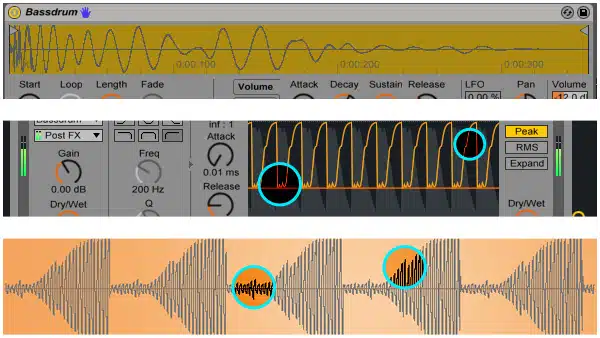
The dynamic range in audio brings a layer of complexity and diversity, especially evident when we explore genres like hip-hop, EDM, and Classical Music.
In Hip-Hop, the emphasis is often on delivering powerful beats and clear vocal performances, which can be achieved through a balanced dynamic range.
This ensures the vocals don’t get lost in the mix and the beats remain impactful.
EDM, known for its pulsating beats and atmospheric sounds, utilizes dynamic range to build tension and release.
This is essential for creating those irresistible, iconic drops.
Well-managed dynamic ranges allow for the clarity of synth lines, the punch of the drums, and the overall energy that EDM is celebrated for.
Classical music, on the other hand, is a genre that thrives on the nuances of wide dynamic range.
The delicate pianissimos and the powerful fortissimos are integral to the emotional expression in classical compositions.
Whatever you produce, make sure to learn how the dynamic range most benefits it.
Measuring and Shaping Dynamic Range
When you’re attempting to measure and shape dynamic ranges, it’s a pivotal task.
It acts as the compass guiding you through the intricate landscape of sound creation and manipulation.
-
Tools of the Trade: How to Measure Dynamic Range
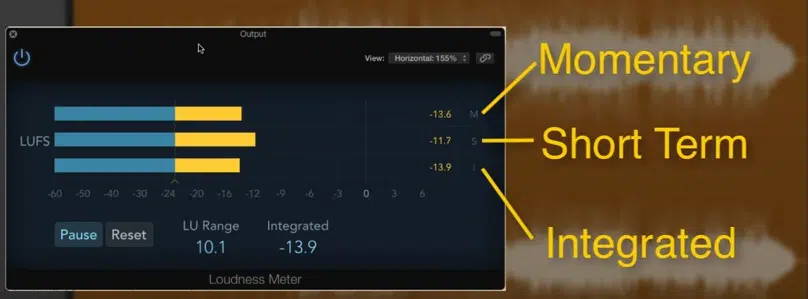
To navigate through the world of dynamic range, a variety of tools are at our disposal.
Measuring dynamic range is a crucial step in the audio production process, allowing us to quantify the difference between the loudest and quietest parts of a track.
Some of the most commonly used tools include:
- Dynamic Range Meters
- Loudness Meters
- Waveform Editors
Each specific tool is beneficial in differentiating between the loudest and quietest parts of your track.
Dynamic Range Meters provide a visual representation of the track’s dynamic range, offering insights into the variations in volume levels.
Loudness Meters, on the other hand, measure the perceived loudness of audio, which is essential for ensuring consistent playback levels across different platforms and devices.
Waveform Editors display the audio signal graphically, helping you to visually inspect the dynamic range and make precise adjustments.
To achieve maximum dynamic range in your productions, investing in high-quality audio gear is essential, ensuring that the loudest sound is clear, impactful, and free of distortion.
Utilizing these tools effectively allows for a nuanced approach to measuring and shaping dynamic range.
It can lay down the foundation for a balanced and captivating sonic experience.
-
Sculpting Sound: Manipulating Dynamic Range for Impact
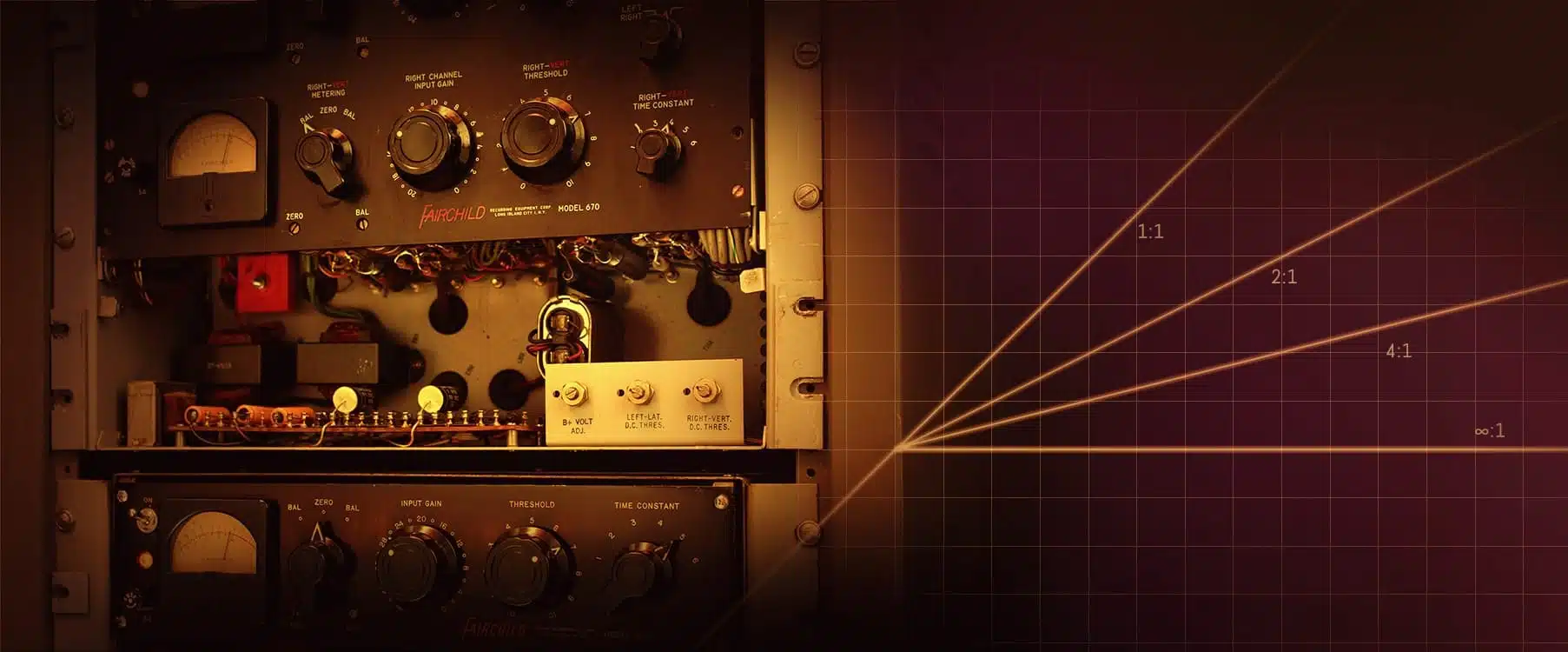
Once you’ve measured the dynamic range, the artistry comes into play.
Sculpting sound involves manipulating the dynamic range to create impact, evoke emotions, and convey the musical narrative effectively.
Certain techniques are employed to shape the dynamics of your audio, such as:
- Compression
- Limiting
- Automation
If you’re not sure exactly how these techniques work, here is a brief description…
Compression is used to reduce the dynamic range by attenuating the loudest parts of the audio.
This helps bring out the more subtle details and ensures a more consistent, fluid, professional sound.
Limiting (a form of compression) prevents the audio from exceeding a certain level.
Meaning, it ensures there isn’t any distortion or clipping.
Automation allows for real-time adjustments to volume, panning, and other parameters 一 enabling you to create dynamic variations and movements within your track.
By masterfully applying these techniques, you can successfully sculpt the sound to achieve the desired impact and emotion; enhancing the overall listening experience.
Dynamic Range Compression
Moving further into the depths of sound manipulation, dynamic range compression stands as a powerful tool, with its own set of principles and best practices.
Let’s discuss it’s intricacies.
-
Compression 101: The Basics Every Producer Should Know
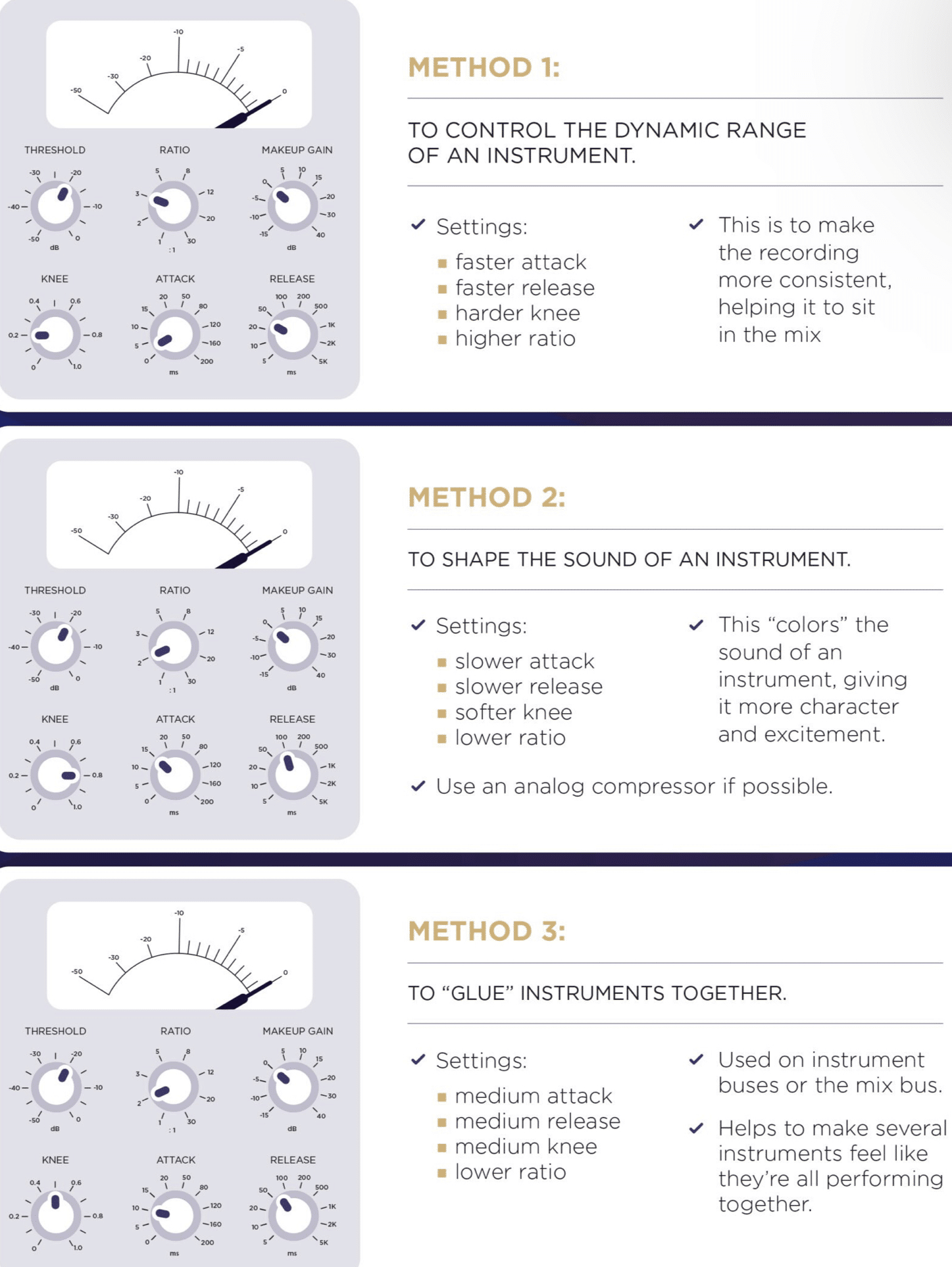
Compression is a cornerstone of music production, fundamentally altering the dynamic range of audio signals.
At its core, compression reduces the difference between the loudest and softest parts of a track by lowering the volume of the peaks.
Understanding the key components of a compressor is critical for any producer, including:
- Threshold
- Ratio
- Attack
- Release
- Makeup gain
For instance, setting the threshold determines the level at which the compressor starts to work.
A lower threshold means more compression; affecting a significantly larger part of the signal.
The ratio sets the degree of compression, where a higher ratio results in a more pronounced compression effect.
Producers should also be mindful of the attack and release settings.
A fast attack time will tame transients quickly 一 but it might make the compression more noticeable and affect the naturalness of the sound.
Conversely, a slower release time can make the compression less apparent but might cause pumping effects if not set correctly.
Exploring these settings in different scenarios (such as compressing a snare drum versus a vocal track) will help build a foundational understanding of compression.
-
The Best Practices for Effective Compression
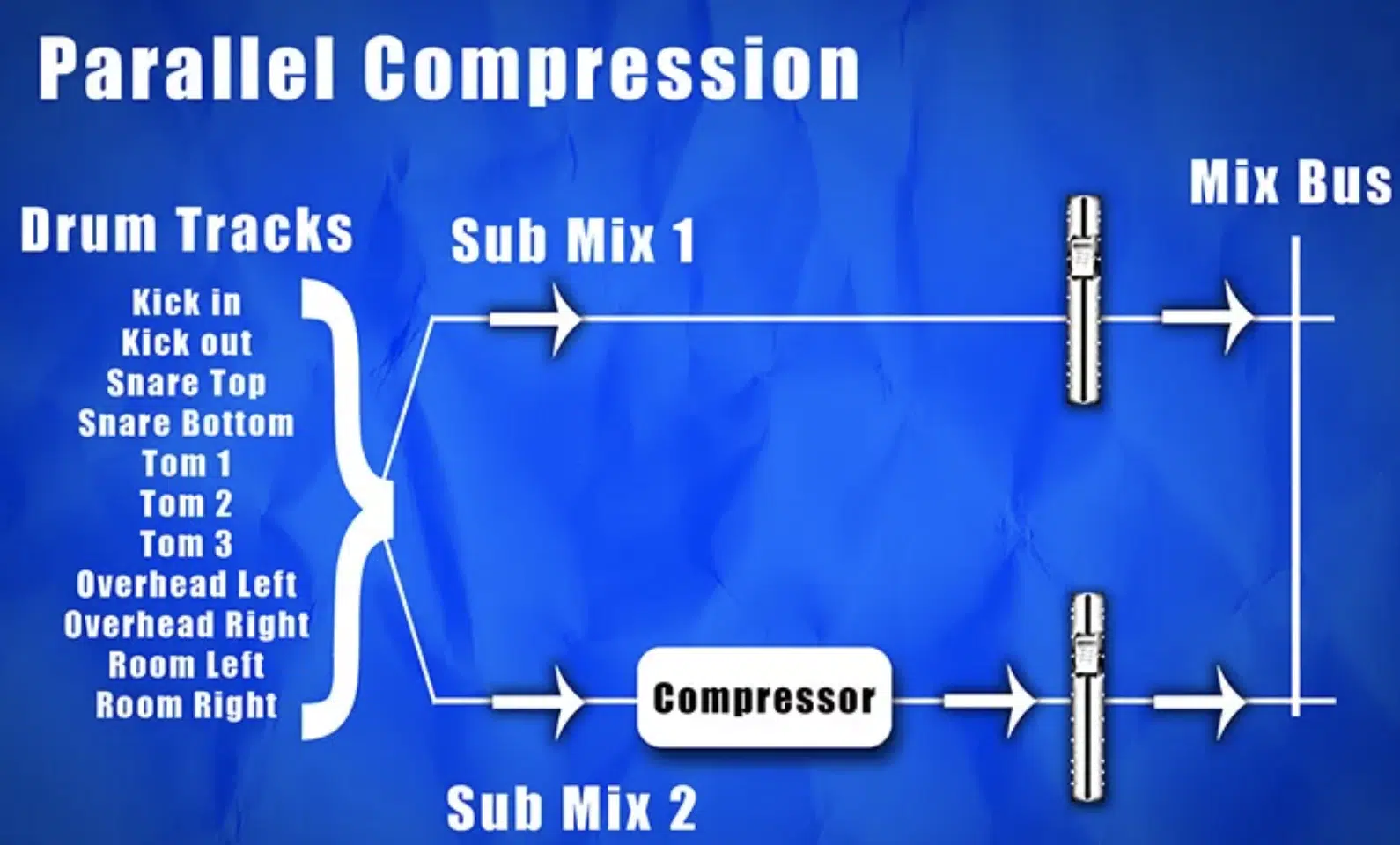
Effective compression is about enhancing the audio without compromising its integrity.
One best practice is to use compression subtly; it’s often better to apply a small amount of compression multiple times in the signal chain rather than a large amount all at once.
This technique (known as serial compression) can maintain a more natural sound while controlling dynamics.
Parallel compression is another effective technique, where the original audio signal is mixed with a heavily compressed version of the same signal.
This approach can maintain the dynamic range while adding body and presence to the sound 一 commonly used to add punch to drum tracks or weight to vocals.
Additionally, always consider the context in which compression is used.
For example, a jazz recording might benefit from a light touch, preserving the natural dynamics of the instruments.
On the other hand, an EDM track might require heavier compression to achieve a consistent and impactful sound.
-
Tips & Tricks to Mastering Compression with Dynamic Ranges
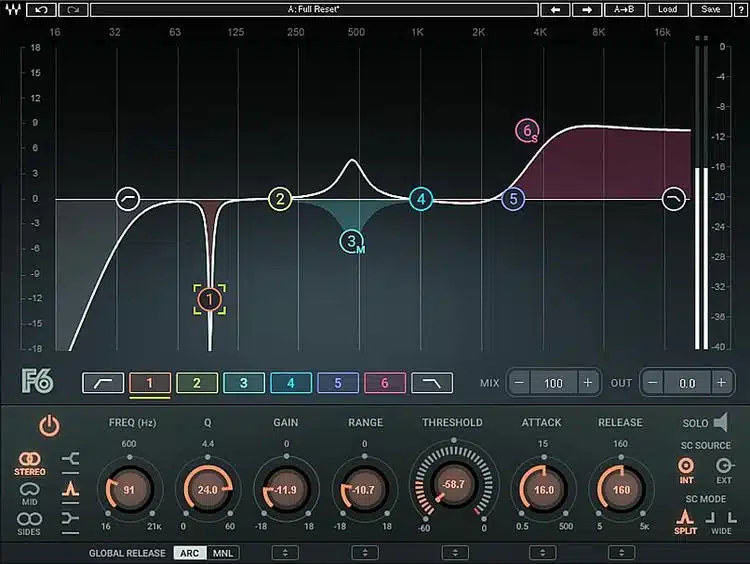
Mastering compression requires a blend of technical knowledge and creative intuition.
One tip is to use sidechain compression, where the compressor is triggered by a different audio source.
This is a popular technique in dance music to make the kick drum cut through the mix, by ducking the volume of the bassline every time the kick hits.
Another trick is to utilize multiband compression.
This divides the frequency spectrum into different bands and allows for different compression settings for each band.
This technique can solve issues of uneven frequency balance and help in enhancing the clarity and punch of a mix.
Exploring different types of compressors can also add different colors and textures to your sound, like:
- Optical
- VCA
- FET
- Variable-mu
Each have their own unique characteristics and can benefit your tracks in different ways.
For example, an optical compressor might be chosen for its smooth and musical compression on vocals, while a FET compressor’s fast attack could be perfect for adding snap to a snare drum.
Learning these types of compressors can greatly benefit the professionalism of your music, and luckily, we’ve broken them all down here.
If you’re wondering how to get your drums to knock using classic compressors (and parallel compression), we’ve got you covered.
Understanding Signal-to-Noise Ratio
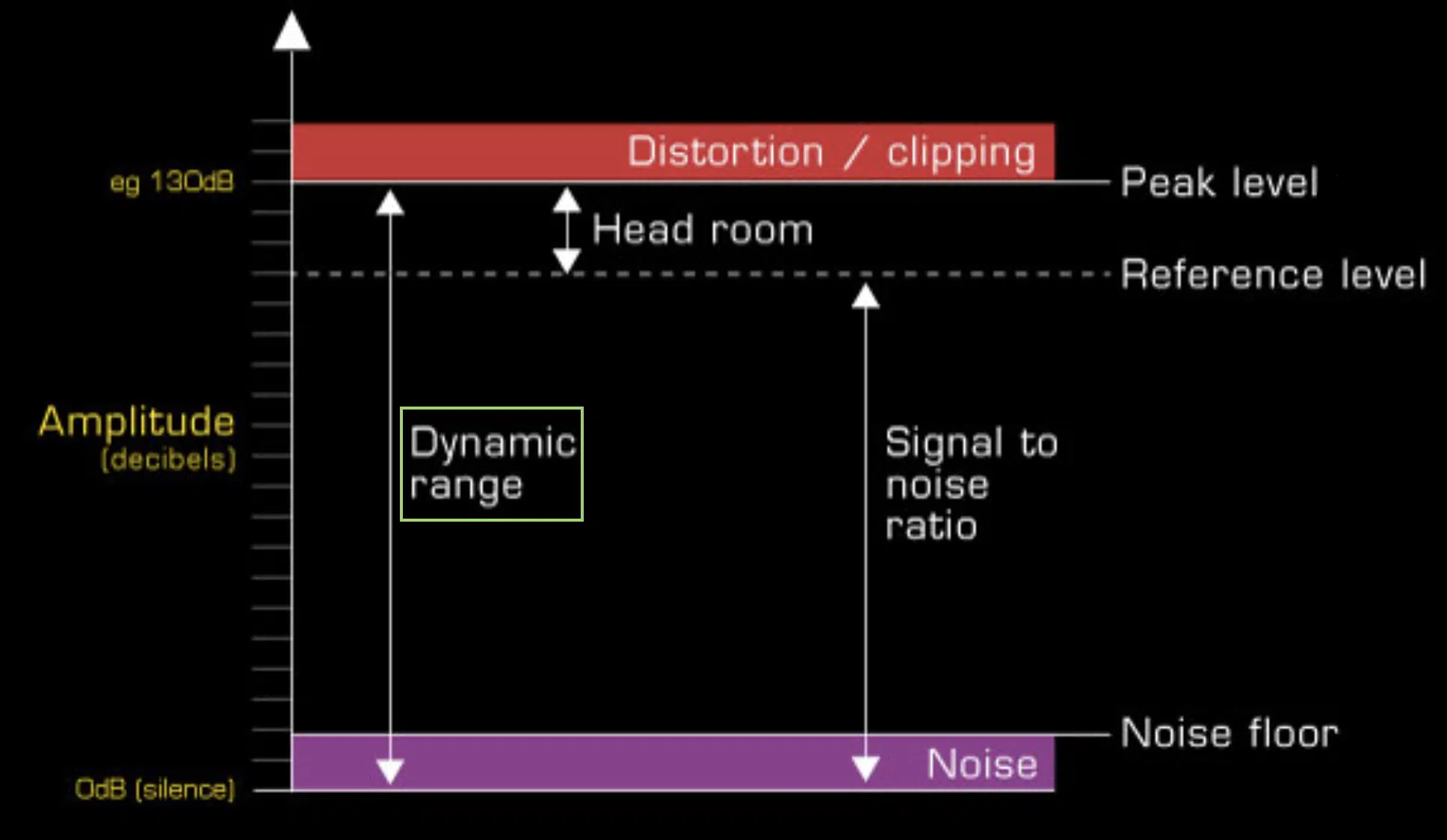
Signal-to-Noise Ratio (SNR) is a critical concept in audio production, representing the proportion between the useful signal and unwanted noise.
A higher SNR indicates a cleaner, clearer sound, where the details and nuances of the audio are not masked by noise.
In practical terms, you might encounter SNR considerations when recording audio.
For instance, you can capture a stronger signal and reduce the amount of noise introduced by:
- Using high-quality microphones and preamps
- Ensuring optimal mic placement
Additionally, recording at a higher bit depth can increase dynamic ranges and subsequently improve the SNR, resulting in cleaner recordings.
It’s all about making sure you have the clearest, most pristine final products.
Which you can certainly accomplish with the help of the signal-to-noise ratio, especially if you’re recording artists in your home studio (just ask audio engineers).
Managing The Noise Floor in Your Mix
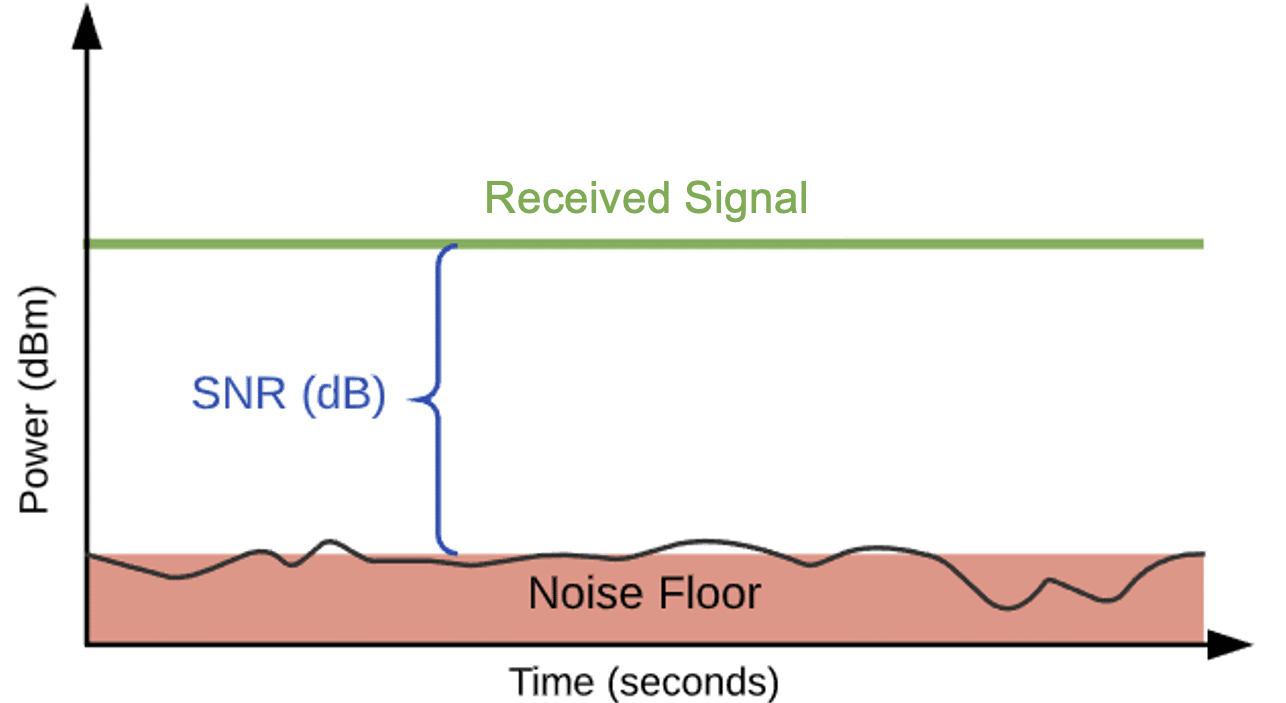
Managing the noise floor is essential to maintain the clarity and fidelity of a mix.
The noise floor refers to the level of background noise in a signal or a recording environment.
NOTE: Any sound below the noise floor level is generally inaudible (below the range of human hearing) but can still affect the overall quality of the mix.
Strategies to manage the noise floor include using high-pass filters to remove unnecessary low-frequency content.
Which, by the way, can contribute to a muddy mix.
Additionally, employing noise gates can help in eliminating unwanted background sounds by only allowing signals above a certain threshold to pass through.
Careful gain staging is also critical.
By ensuring that each element in the mix is at an appropriate volume level, you can minimize the accumulation of noise.
As well as avoid introducing additional noise through excessive amplification.
So, By effectively managing the noise floor, you not only maintain audio clarity but also create a cleaner canvas for emphasizing the intricacies and nuances of your mix.
Bonus: Streaming Services & Loudness Normalization
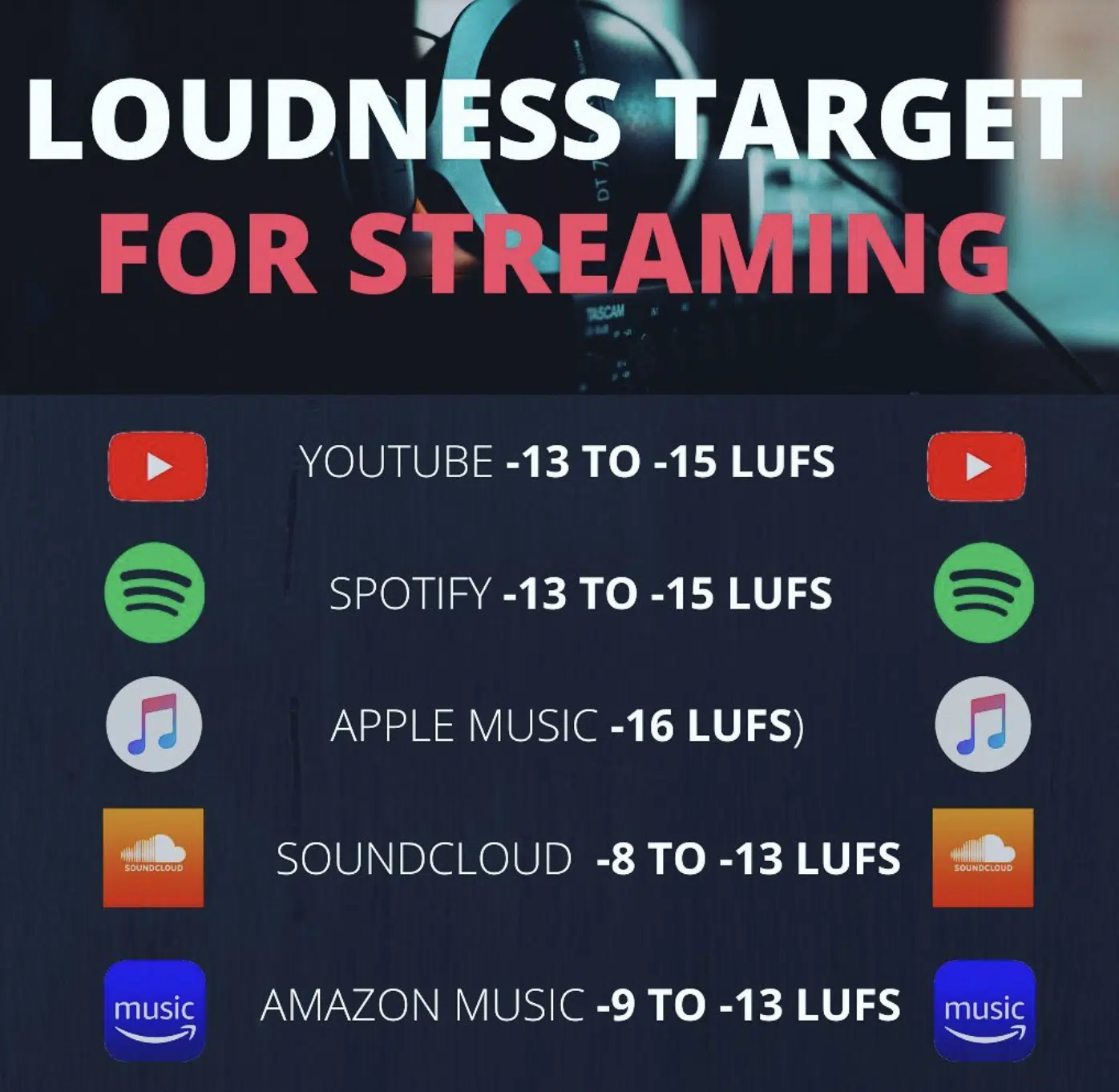
Streaming services have introduced new challenges and opportunities for music producers, especially regarding a feature called loudness normalization.
Platforms like Spotify, Apple Music, and YouTube employ loudness normalization to provide a consistent listening experience across different tracks and albums.
For music producers, this means being aware of the loudness standards set by these platforms.
An audio track that is too loud might be turned down by the platform’s normalization process, potentially affecting its perceived quality and impact.
For example, Spotify uses a loudness target of -14 LUFS (Loudness Units Full Scale), and tracks exceeding this level will be attenuated.
Adapting to these specific standards is crucial.
It involves striking a balance between achieving a competitive loudness level while preserving your dynamic ranges and avoiding excessive compression.
NOTE: Over-compression can can lead to a loss of punch and clarity, so avoid it at all costs.
Keeping informed about the specifications of different streaming services and testing how mixes translate across platforms are essential practices in the current digital audio landscape.
Dynamic Range Audio: Final Thoughts
So, as you now know, dynamic range in audio is pivotal in creating impactful and well-balanced tracks.
It can transform the sonic landscape of your tracks, allowing for greater expression and emotional depth.
Understanding and manipulating dynamic range audio is the key to producing music that stands out and engages the listener on a deeper level (get them hooked, if you will).
Now, after this article, you’re equipped with the knowledge and techniques to handle dynamic range audio like a pro.
Whether you’re attempting to accentuate the subtleties in the quietest sections or manage the intensity of the loudest parts, you’ll be able to do it all.
The comprehensive insights and practical tips provided will enable you to shape your music’s sonic dynamics with precision and creativity.
And speaking of creativity, you absolutely need the highest-quality audio elements, like these legendary Free Guitar Loops.
These loops, offering 7 of the most epic free guitar loops with matching audio & MIDI stems, are meticulously crafted and can serve as excellent study material.
By analyzing these guitar loops, you can gain insights into how dynamic range is managed and replicated 一 further enhancing your skills in manipulating dynamic range audio.
With your newfound knowledge of dynamic range audio, you can make music that is dynamic and compelling.
Make sure to keep exploring, experimenting, and most importantly, embracing the vast possibilities that dynamic range audio presents.
Until next time…







Leave a Reply
You must belogged in to post a comment.